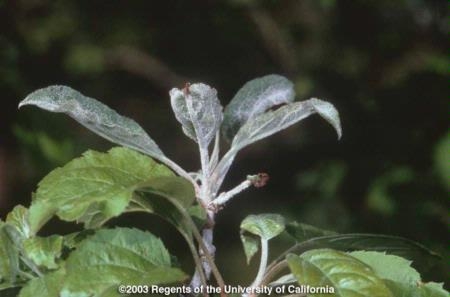Many blue oak trees in California foothills might be more accurately described as “silver oaks” this year. From a distance, they shimmer with a silvery halo. On closer inspection the outermost leaves are coated with a white to gray powdery fuzz.
The cause, according to Doug McCreary of the Integrated Hardwood Range Management Program at UC Berkeley, is powdery mildew. Powdery mildew, a group of fungi that causes a white, flour-like growth on the surface of leaves, is common on roses, begonias, grapes and many other ornamental plants and agricultural crops.

“People have called us worried that the affected trees may be showing signs of SOD, but this is clearly not the cause. SOD symptoms are far different, blue oak is not a SOD host and SOD is restricted to coastal forests,” McCreary said.
McCreary assures oak lovers that powdery mildew rarely kills the majestic trees. Even small seedlings that have all of their leaves severely infected usually survive and recover.
“Powdery mildew makes it more difficult for the affected leaves to photosynthesize and produce food, and if it’s severe enough, it can also result in the leaves distorting, curling up, dying and falling to the ground,” McCreary said. “But most affected trees will simply grow a new crop of leaves later in the summer or the following spring. And if weather conditions return to a more normal pattern next year, with little or no rainfall after March, it is unlikely that powdery mildew would continue to be severe or widespread.”
Some people may be inclined to treat affected trees with fungicides. However, these treatments are most effective when the symptoms first appear, which occurred weeks or months ago. It is also generally not recommended to treat trees in wildland settings. There are too many trees to treat and the potential environmental risks of applying fungicides across a large landscape can outweigh the benefits. Above all, McCreary said, don’t panic and cut down the trees, even if all their leaves fall off.
“The trees are still very much alive,” McCreary said. “Losing their foliage is just the oak’s way of dealing with an unwanted pest. By this time next year they should again be leafed out without that silver covering currently observable.”
The unusually wet March and April is at least partially responsible for the higher-than-normal incidence of powdery mildew in blue oaks, he said. Increased incidence of powdery mildew has also been reported on California black oaks and coast live oaks on the coast.
“Powdery mildew doesn’t need rainfall, but it is favored by warm conditions, high humidity and low light and it loves young, succulent foliage,” McCreary said. “Because California was blessed with above average rainfall this past spring, there has been – and continues to be – considerably more moisture in the soil. Under these conditions, oak trees will grow a ‘second flush’ of leaves, usually in May or early June, that is very susceptible to powdery mildew.”